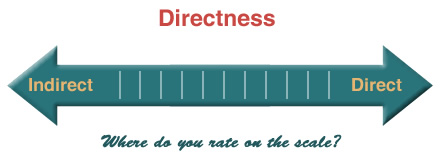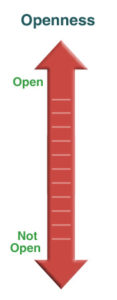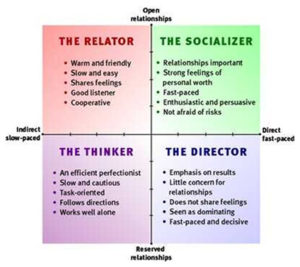The Different Types of Communication Styles
Today we’re going to discuss the different communication styles and how they affect our interpersonal relationships. We’ll look at some different ways of categorizing these types of communications styles and we’ll learn about our own dominant style.
When discussing communication theory, personality traits and behaviors all seem to get thrown into the mix. The styles go by different labels, and almost always seem to come in groups of four, probably the result of Hippocrates “Four Temperaments” that he developed from the “Four Humors” theory some time ago. Eastern and Western thinkers have their respective versions of the “Four Elements” theory (sometimes “five elements” depending upon your discipline) that can be associated with personality traits. There has been a chain of philosophers and psychologists through the centuries that have proposed their own versions of these communication types.
You will sometimes see communication styles categorized as Aggressive, Passive, Assertive, and Passive-aggressive (again four). Though these descriptors are valid when describing communicators, there are more accurate ways to define the styles and refine our interpretation of them.
What is Your Style?
There is a nice exercise that Dave Jensen came up with in an article for Science Magazine online. This is a two-part exercise that we’re going to undertake that will help you to determine your communication style or that of anyone else with whom you interact. We’re going to break down your style into two different scales, and then we will combine the two to obtain an overall picture.
Directness
First, you want to imagine a scale running left to right. This is our scale of directness. At the far right is the most direct person that you can imagine: Driven, outgoing, fast-paced, LOUD. Do you know anyone like that? Is it you perhaps? How about someone at the far left end of the scale; do you know anyone who is the opposite of direct; someone who is slower paced, indirect, circular, meandering? Take a moment to think about people you know who fall somewhere on this scale. Where do you fall on this scale of directness?

(Please note that we need to refrain from judging. There are no good or bad styles here. At most, the styles could be considered effective or ineffectual depending upon whether the style is meeting our needs or not. Also, it is important to consider that any style can be effective, depending upon the circumstances of the given situation.)
Where is your style on the scale? Where is the style of your spouse or significant other? Where is the style of your mother or father or siblings? What about your co-workers; more specifically, that co-worker with whom you just cannot seem to stand?
Openness
 The second scale we will work with is the Openness scale. It runs vertically, and will have a very open-typed personality style at the top and a very “non-open” type style at the bottom. Where do you fall on this scale? Do you share your feelings and opinions freely, openly and often? Are you very accessible and expansive? Or are you more like me and are a little more inhibited with your inner workings. Again, there is no right or wrong here. Once you’ve thought about it a little bit, we’ll then put the two scales together.
The second scale we will work with is the Openness scale. It runs vertically, and will have a very open-typed personality style at the top and a very “non-open” type style at the bottom. Where do you fall on this scale? Do you share your feelings and opinions freely, openly and often? Are you very accessible and expansive? Or are you more like me and are a little more inhibited with your inner workings. Again, there is no right or wrong here. Once you’ve thought about it a little bit, we’ll then put the two scales together.
Here is the chart of the two combined scales. Know that you will see as many different versions of this chart as you will encounter different communication styles – well, maybe not that many, but a lot. The Socializer has other names such as the Butterfly, or a much more dignified Initiator. The Thinker, logically –ha, can also be known as the Analyzer.


So What?
How can we use this information? As a Master Communicator, we need to know our strengths and our limitations. All great leaders do. Here’s a fitting quote:
A leader needs to know his strengths as a carpenter knows his tools, or as a physician knows the instruments at her disposal. What great leaders have in common is that each truly knows his or her strengths – and can call on the right strength at the right time. This explains why there is no definitive list of characteristics that describes all leaders.
~ Dr. Donald O. Clifton
Accepting for the moment that we do want to be great leaders and communicators, we need to know where our communication preferences lean, keeping in mind that these preferences are not necessarily static; they can and do change over time. Knowing our own predilection, we can then be aware of how they inter-relate with the styles of others with whom we communicate. And believe it or not, the greatest practice we can entertain is to consider our relationships with those who annoy the hell out of us. These challenging people and these relationships are our greatest teachers.
Think about someone with whom you’re having troubles. Take some time, try to release all judgment about the situation and all opinions and feelings about the person. Try to look at the situation objectively. Where does the person fall on the chart? What type of communicator is he or she? How does that fit with your style? Obviously it doesn’t really, otherwise you wouldn’t be having troubles now would you?
You know that you are a Master Communicator. Part of your power lies in the fact that you are able to adapt your style to the style of others. Some may consider this a weakness. They may view this adaptability as being wishy-washy. This is not true, unless you are not achieving your own goals or desires. It does not mean that you are shrinking, or being unnatural. It doesn’t mean that you’re not being true your own self. In fact, there is another category that we could squeeze into the scales that will describe the effective communicator – the Adaptor. His or her traits include: sensitivity, awareness, courage, and intelligence. If this is you, friend, you are a Master Communicator. Keep up the good work. There is always more to learn and ways to grow. In the next article, we’ll discuss Communication Strategy to help us with our problem situations.
Cultural Communication
We’ve already discussed the thin line that separates culture from communication; that is if there is any line at all. If that is the case, then given the many different cultures on the planet, there must be equivalent forms of communication that relate to those cultures. You’ve heard the phrase “culture clash.” If there is such a thing then there must be a “communication clash” as well when cultures interact. Cross cultural communication styles is a study that we will take up in another article.
—-
Get Paid to Write
Turn the writing skills you already have into a highly-paid recession-proof profession …working part time! You’re already a writer. Find out how you can earn $100 to $150 per hour from this little-known lucrative profession.













Please comment with your real name using good manners.